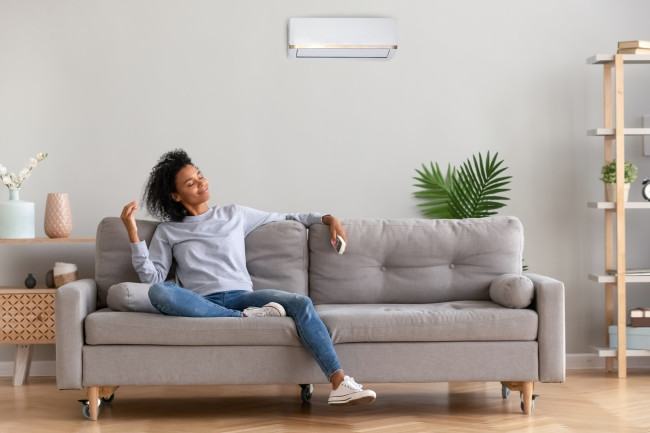I love my portable air conditioner even though it has a lot of quirks

Fans just weren’t doing the trick anymore for one New Yorker, and a regular window air conditioner wouldn't work, either.
iStock
I am fine sweating through a summer without air conditioning, but my husband decided he is not, so we had to come up with a solution to cool off our New York City apartment. Our many fans just weren’t doing the trick anymore.
We didn’t want to block our one living room window or compromise its soundproofing with a window air conditioner, so we decided to try a portable air conditioner. Our research indicated these were not very good: They were expensive, bulky, noisy, and inefficient. Consumer Reports called them a “cooling choice of last resort.” But installing a window air conditioner would be a huge inconvenience. We couldn’t do it ourselves, and it came with a pricey recurring charge of around $250 for installation, and then removal and storage each season.
[Editor's note: An earlier version of this post was published in June 2020. We are presenting it again in case you missed it.]
So, my mission became to find a suitable used portable unit. I scoured Craigslist daily, hoping to fine one fairly close by so we could bring it home in a cab without spending a fortune. And I wanted one that was short enough to store under our dining table when not in use. This was tough, since these appliances are typically more tower-like than cube-like.
My goal was also to find one that was relatively inexpensive because as first-time users we didn’t know what to expect. New, standalone units average around $350, far more than a window unit, which you can get for $150 or even less.
Then I found it. The seller, who was moving, lived just one block away. She was selling a Costway 10,000 BTU portable air conditioner. We tested it in her apartment, and it worked. So, we handed her $120 cash and wheeled it home. My husband hoisted our R2-D2-like unit up the stairs, all 52 pounds.
Are portable air conditioners hard to install?
The first problem: The window kit didn’t fit. Instead of accordion side panels, these air conditioners come with an adjustable sliding panel. Ours was too long. I took it to Supreme Hardware, which charged me $3 to lop off a few inches. We didn’t screw our window kit into the window frame because we wanted to be able to remove it and close the window if there was construction outside.
The instructions said to keep the exhaust hose as straight and short as possible. Well, the window is waist-high, and the hose exits from the bottom of the unit. So, a bendy hose it would have to be, with an awkward and bulky S curve.
And it took up a lot of space. We had to move some furniture so it would fit.
We tried it on the first hot day. Relief! Then a few hours later, we noticed water soaking the rug underneath. Our attempts to drain the water merely made the rug underneath wetter. Fearing mold, we blotted the water and ran the fan to dry the rug. This happened four days in a row.
How do you prevent leaks from a portable AC?
Finally, we found a shallow plastic container, no more than half an inch deep, which fit beneath the drain hole to collect the stream of water when we unplugged the hole. Online, I found an assortment of drain-related accessories—hoses, clamps, and elbow fittings. Draining problems seems to be a common issue. We added a plastic floor mat, the kind for rolling chairs, in case of drips or overflows.
Meanwhile, we grappled with the exhaust hose—an unwieldy, collapsible plastic tube. It attached to both the machine and the window kit with plastic collars, which dislodged whenever we removed the window kit to close the window. We finally figured how to twist and snap the parts into place. Twisting was the key.
How do portable ACs work?
With a window air conditioner, the cool air comes out the front and the warm air goes out the back, into the outdoors. With portables, the warm air gets vented out the window through the hose, making the hose warm up.
So, while cool air was cooling the room, the hose was, at a slower rate, adding heat. Maybe that was one reason why, no matter the setting, our thermometer never went below 80 degrees.
But our machine was good enough for us. We needed air conditioning only on the hottest days. In our 200-square-foot living room, it was sufficient to take the edge off the heat. It made a soothing fan noise without any kind of annoying, motorized sound.
It occurred to me that I needed to maintain the inside of the machine, so I watched some eye-opening videos. Some people took the whole thing apart with a screwdriver and uncovered crusted dust coating the coils. Never have I felt so unprepared to live in hot weather.
One friend who has portable air conditioners says she drains hers every day, and often sprays colloidal silver solution into the vents to curb microbial growth. We haven’t taken this step.
Once we learned its many quirks, we were happily surprised by our portable air conditioner—so much so that I gush about it to every visitor. For us, it is far better than a window unit.
At summer’s end, we followed the instructions for cleaning the filters and running fan mode for a few hours, to prepare for storage under our table. Best of all, there was no need to schedule removal, or to pay for it. Then last week, we wheeled out our little machine, positioned it by the window, happily pressed the power button, and smiled.
You Might Also Like





























